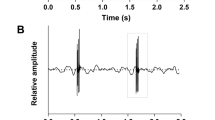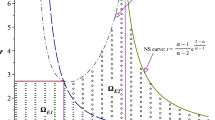Abstract
We explore the dynamics of a time-variant prey–predator model of two species of fishes, namely Tenualosa ilisha (prey) and Macrognathus pancalus (predator). The prey exhibits anti-predatory behavior due to fear of predation. The prey equation is also equipped with age-based growth and harvestation terms to investigate the significance of maturity and harvest delay. The prey moves from saline water to freshwater for spawning, during which the predator feeds on an alternative food source. We explore the impact of this food source on the survival of prey. Starting with the sufficient conditions for positivity and boundedness of the solutions to the model, we find conditions for the existence of a stable global solution, periodic and almost periodic solutions. We find the range of existence for prey and predator populations and observe the interdependence between these values. According to our findings, just the fear of predation is enough to drive the prey population low. Even when the prey happens to be in an advantageous scenario, fear can still bring its population down, unless there are no or very few predators.






Similar content being viewed by others
References
Zanette LY, White AF, Allen MC, Clinchy M (2011) Perceived predation risk reduces the number of offspring songbirds produce per year. Science 334(6061):1398–1401
Moller AP, Christiansen SS, Mousseau TA (2011) Sexual signals, risk of predation and escape behavior. Behav Ecol 22(4):800–807
Clinchy M, Sheriff MJ, Zanette LY (2013) Predator-induced stress and the ecology of fear. Funct Ecol 27(1):56–65
Cresswell W (2010) Predation in bird populations. J Ornithol 152(S1):251–263
Cherry MJ, Morgan KE, Rutledge BT, Conner LM, Warren RJ (2016) Can coyote predation risk induce reproduction suppression in white-tailed deer. Ecosphere 7(10):e01481
Mpemba H, Karanja H, Jiang G (2019) Predation fear, prey behavior, and community structure: a brief review of their relationship. Am Int J Biol 7(1):1–7
Wang X, Zanette L, Zou X (2016) Modeling the fear effect in predator–prey interactions. Math Biol 73(5):1179–1204
Wang X, Zou X (2017) Modeling the fear effect in predator–prey interactions with adaptive avoidance of predators. Bull Math Biol 79(6):1325–1359
Mondal S, Maiti A, Samanta GP (2018) Effects of fear and additional food in a delayed predator–prey model. Biophys Rev Lett 13(4):157–177
Wang J, Cai Y, Fu S, Wang W (2019) The effect of the fear factor on the dynamics of a predator–prey model incorporating the prey refuge. Chaos Interdiscip J Nonlinear Sci 29(8):083109:1-10
Zhang H, Cai Y, Fu S, Wang W (2019) Impact of the fear effect in a prey–predator model incorporating a prey refuge. Appl Math Comput 356(1):328–337
Duan D, Niu B, Wei J (2019) Hopf–Hopf bifurcation and chaotic attractors in a delayed diffusive predator–prey model with fear effect. Chao Solitons Fract 123:206–216
Pal S, Majhi S, Mandal S, Pal N (2019) Role of fear in a predator–prey model with Beddington–DeAngelis functional response. Zeitschrift Für Naturforschung A 74(7):581–595
Pal S, Pal N, Samanta S, Chattopadhyay J (2019) Fear effect in prey and hunting cooperation among predators in a Leslie–Gower model. Math Biosci Eng 16(5):5146–5179
Das A, Samanta GP (2018) Modeling the fear effect on a stochastic prey–predator system with additional food for the predator. J Phys A Math Theor 51(46):1–37
Roy J, Alam S (2019) Fear factor in a prey–predator system in deterministic and stochastic environment. Phys A 66:123359
Bhaumik U (2015) Migration of Hilsa shad in the Indo-Pacific region—a review. Int J Curr Res Acad Rev 3(11):139–155
Raja BTA (1985) A review of the biology and fisheries of Hilsha Ilisha in the Upper Bay of Bengal. Marine Fisheries Resources Management in the Bay of Bengal, Colombo
Bhaumik U (2015) Review of global studies on food, growth and maturity profile of Indian shad (Tenualosa ilisha). Int J Curr Res Acad Rev 3(10):127–139
Milton DA (2010) Status of hilsa (Tenualosa ilisha) management in the Bay of Bengal: an assessment of population risk and data gaps for more effective regional management. Bay of Bengal Large Marine Ecosystem Project, Phuket
Suresh VR, Sajina AM, Dasgupta S, De D, Chattopathyay DN, Behera BK, Ranjan R, Mohindra V, Bhattacharya S (2017) Current status of knowledge on Hilsa. ICAR-Central Inland Fisheries Research Institute, Barrackpore
Dutta S, Maity S, Chanda A, Hazra S (2012) Population structure, mortality rate and exploitation rate of Hilsa Shad (Tenualosa Ilisha) in West Bengal coast of northern Bay of Bengal, India. World J Fish Marine Sci 4:54–59
Amin SMN, Rahman MA, Haldar GC, Nahar S, Dewan S, Mazid MA (2000) Population dynamics of jatka (Juvenile hilsa) in the Meghna river, Bangladesh. Asian Fish Sci 13:383–389
Bala BK, Arshad FM, Alias EF, Sidique SF, Noh KM, Rowshon MK, Islam MM (2014) Sustainable exploitation of hilsa fish (Tenualosa ilisha) population in Bangladesh: Modeling and policy implications. Ecol Model 283:19–30
Skonhoft A, Vestergaard N, Quaas M (2012) Optimal harvest in an age structured model with different fishing selectivity. Environ Resour Econ 51(4):525–544
Jana D, Dutta S, Samanta GP (2019) Interplay between reproduction and age selective harvesting: a case study of Hilsa (Tenualosa ilisha) fish at Sundarban estuary of northern Bay of Bengal, India. Int J Biomath 12(02):23
Talwar PK, Jhingran AG (1991) Inland fishes of India and adjacent countries. A.A. Balkema, Rotterdam, p 2
Shrestha J (1994) Fishes, fishing implements and methods of Nepal. Smt, M.D., Gupta, Lalitpur Colony, Lashkar (Gwalior), India
Vishwanath W (2010) Macrognathus Pancalus, The IUCN Red List of Threatened Species, IUCN 2011, version 2011.2
Serajuddin M, Ali R (2005) Food and feeding habits of striped spiny eel, Macrognathus pancalus (Hamilton). Indian J Fish 52(1):81–86
Ganguli C, Kar TK, Das U (2018) Consequences of providing alternative food to predator in an exploited prey predator system controlled by optimal taxation. Int J Nonlinear Sci 25(3):131–150
Arino J, Wang L, Wolkowicz GSK (2006) An alternative formulation for a delayed logistic equation. J Theor Biol 241(1):109–119
Beddington JR (1975) Mutual interference between parasites or predators and its effect on searching efficiency. J Anim Ecol 44(1):331–340
Liu S, Beretta E, Breda D (2010) Predator–prey model of Beddington–DeAngelis type with maturation and gestation delays. Nonlinear Anal Real World Appl 11(5):4072–4091
Baalen MV, Krivan V, Van Rijn PCJ, Sabelis MW (2001) Alternative food, switching predators, and the persistence of predator–prey systems. Am Nat 157(5):512–524
Samanta S, Dhar R, Elmojtaba IM, Chattopadhyay J (2016) The role of additional food in a predator–prey model with a prey refuge. J Biol Syst 24(2–3):345–365
Fan M, Kuang Y (2004) Dynamics of a nonautonomous predator–prey system with the Beddington–DeAngelis functional response. J Math Anal Appl 295(1):15–39
Li H, Takeuchi Y (2015) Dynamics of the density dependent and nonautonomous predator–prey system with Beddington–DeAngelis functional response. Discrete Contin Dyn Syst B 20(4):1117–1134
Zeng Z, Fan M (2008) Study on a non-autonomous predator–prey system with Beddington–DeAngelis functional response. Math Comput Model 48(11–12):1755–1764
Viadero RC (2005) Factors affecting fish growth and production. Water Encycl 3:129–133
Schmulbach CJ (1959) Factors affecting the harvest of fish in the Des Moines River, Boone County, Iowa, Retrospective Theses and Dissertations, 2594
Greggor AL, Jolles JW, Thornton A, Clayton NS (2016) Seasonal changes in neophobia and its consistency in rooks: the effect of novelty type and dominance position. Anim Behav 121:11–20
Gaines RE, Mawhin RM (1977) Coincidence degree and nonlinear differential equations. Springer
Bartle RG, Bartle RG (1964) The elements of real analysis. Wiley, New York
Das I, Hazra S, Das S, Giri S, Maity S, Ghosh S (2018) Present status of the sustainable fishing limits for hilsa shad in the northern Bay of Bengal, India. Proc Natl Acad Sci India Sect B Biol Sci 89:66
Hossain MAR, Das I, Genevier L, Hazra S, Rahman M, Barange M, Fernandes JA (2019) Biology and fisheries of Hilsa shad in Bay of Bengal. Sci Total Environ 651(2):1720–1734
Haldar GC, Amin SMN (2005) Population dynamics of male and female hilsa, Tenualosa ilisha of Bangladesh. Pak J Biol Sci 8:307–313
Suraci JP, Clinchy M, Zanette LY, Wilmers CC (2019) Fear of humans as apex predators has landscape-scale impacts from mountain lions to mice. Ecol Lett 23:5
Author information
Authors and Affiliations
Corresponding author
Appendix
Appendix
The effect of fear is incorporated at the very basic step of the model. In order to understand the upcoming explanation, we have to keep in mind that it is a scientific modification of the logistic growth model. We know that the logistic growth model is given by
When written mathematically,
where N(t) is the density of the population (for the present system it is a prey population) at time \(t, b(t), \delta (t)\), and c(t) are natural/linear birth/reproduction rate, natural/linear death rate and death rate due to competition among themselves for resources. But when predator (P(t)) is incorporated into the system, then due to fear, natural/linear birth/reproduction rate (b(t)) is affected (refer to [7]) and, it becomes b(t)f(k(t), P(t)) where \(f(k(t),P(t))=\dfrac{1}{(1+k(t)P(t))}\) (fear-effect term). Finally, the logistic model becomes
where \(\dfrac{b(t)}{1+k(t)P(t)}\) indicates the modified birth rate due to fear of predator.
Now according to the characteristics of prey (in the present system, it is a sexually reproductive species), it can give birth/reproduce after becoming sexually mature. That means those born now, they cannot give birth now, but those born before \(\tau _1\) time from now and still alive and manage to survive during \(t- \tau _1 \) time which has attained maturity (can reproduce) and contributes to the birth rate of the population. To obtain an equation that describes how many individuals alive at time \(t- \tau _1 \) are still alive at time t, we solve the following rst order ODE for N(t) as a function of \(N(t- \tau _1)\), where \(N(t- \tau _1 )\) is the density of prey at time \(t- \tau _1\). \( \{- \delta (t) N(t)-c(t) N^2 (t) \} \) is the total death at time t, so:
Using the technique of separation of variables and integrating on both the sides from \(t- \tau _1\) to t, it follows that
And hence,
is the population that contributes to the birth rate at time t in prey population. Now we replace it in equation (A2); thus, we have
So, finally the modified logistic equation is:
In the present study, the hilsa fish population (if we think about a single population model in the absence of the predator) is given by (along with the harvesting term, which can be derived in a similar manner, i.e., those born before \(\tau _2\) time from now and alive during \(t- \tau _2\) time, these are economically profitable and ecologically sustainable, we can harvest them):
where q(t), and E(t) are catchability coefficient and efforts put into harvesting prey, respectively; \(\tau _1\), and \(\tau _2\) are maturation delays for reproduction and harvesting, respectively.
Next, we consider a predator to the model, then due to the foraging tendency of the predator (towards its prey, for its food), one direct effect (predation, here we consider Beddington-DeAngelis functional response with an alternative food source to the predator) and one fear-effect term (in prey) will be incorporated into the model. Thus, the final prey–predator model (i.e., equation (1.1)) is as follows:
Rights and permissions
About this article
Cite this article
Devi, N.S.N.V.K.V., Jana, D. The role of fear in a time-variant prey–predator model with multiple delays and alternative food source to predator. Int. J. Dynam. Control 10, 630–653 (2022). https://doi.org/10.1007/s40435-021-00809-0
Received:
Revised:
Accepted:
Published:
Issue Date:
DOI: https://doi.org/10.1007/s40435-021-00809-0




